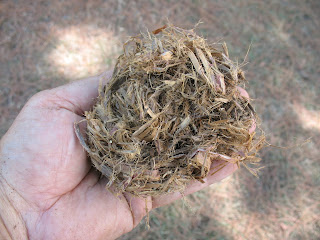It sounds simple, and with a little practice and the right equipment it really is simple. Once you have mastered the technique of primitive fire making and have your equipment prepared and in place, you can consistently start a fire in under one minute.
To make a fire with a bow and drill you will need to prepare six items of equipment. They are a fire-board, a spindle, a handhold, a bow, a bowstring and some tinder. Since the proper selection and preparation of these six items is over half the battle in primitive fire building, let's talk about each one of them in a little more detail:
FIRE BOARD & SPINDLE - The fire-board and spindle should both be made of the same kind of wood. A dry soft wood like yucca stalk or cottonwood root is best. Woods like willow or cedar can be used but are not as good. Avoid hard or resinous woods like oak, hickory or pine. Whatever kind of wood you use, it must be dead and completely dry. Wood that has been dead at least six months is recommended. Pictured below: Yucca plant.

To make a fire board take a stick of wood about an inch to an inch-and-a-half in diameter and about a foot long. Trim off two opposite sides of the stick to leave a flat board about 3/4" thick. Take the point of your knife and dig a small starter hole in the middle of the board about two inches from the right end. Pictured below: top, Section of dry Yucca stalk; middle, Removing sides of the stalk to leave a flat board; bottom, Making a small starter hole in the fire-board.



To make a spindle cut a stick about 3/4" in diameter by ten inches long. Round one end of the stick and carve the other end to a shallow point. Do not smooth the stick off. A rough surface will grip the bowstring better when you are turning the spindle. Pictured below: The spindle.

HANDHOLD - The handhold is the socket that fits on top of the spindle and allows it to turn freely in your hand. The handhold may be made out of hardwood, stone, bone, a seashell or etc. The handhold should fit comfortably in the palm of your hand. The handhold should have a hole in the center that is large enough to accept the rounded end of the spindle and deep enough to keep the spindle from jumping out as it turns. Pictured below: Various different handholds.

BOW - The bow that you will use to turn the spindle can be made from any fairly strong but flexible wood. Oak, hickory, cedar, ash and elm will all make a good bow. You may use these woods green or dry; it really doesn't matter. In fact you don't even have to remove the bark from your bow. Make your bow from a stick that is about 3/4" in diameter and about two feet long. You will need to carve two shallow grooves around the stick to hold the bowstring. Carve one groove about 1/2" from one end of the stick and the other groove about six inches from the opposite end of the stick. This way you will have about a six inch handhold left after you string the bow. Pictured below: Fire bow.

BOWSTRING - You will need about two-and-a-half to three feet of string for your bow. There are many sources of string. You may have some nylon cord with you already. If you are wearing lace-up boots or shoes you can use your shoe laces. You may cut a strip of leather from your belt. You can tear several strips of material from your shirt, skirt or pants and then twist or braid these together to form strong cordage. If you have the knowledge and skill you can make your own cordage from yucca leaves, agave leaves, nettle stems and many other wild plants. In short, your imagination is the only limit when it comes to producing a bowstring.
TINDER - Good quality, dry tinder is very important for primitive fire building. Nothing is more frustrating than to get a good glowing red coal from your fire board and then not be able to set your tinder ablaze with it. In order to catch fire from a glowing coal, tinder must be dry, dry, dry. Finely shredded dead cedar bark makes good tinder. Very dead, very dry shredded grass will work as tinder. Good tinder can be made by unraveling jute or hemp rope to the smallest possible fibers. Old bird's nests make good tinder if they are made of fine grasses and fibers. A good trick to help your tinder catch fire from a coal is to work some very dry cattail fluff or thistle down into the tinder. This fluff or down will not actually blaze up, but it will catch a spark and help spread it throughout the tinder. Pictured below: top, cutting cedar bark from tree; middle, strips of cedar bark; bottom, shredded cedar bark tinder.



Now that we have our materials together, in the next post we will use them to build a fire.



1 comment:
Thanks
Post a Comment